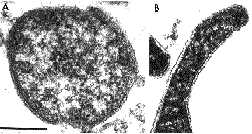Cornell scientists isolate a bioremediation superstar that gobbles up perc and other chlorinated solvents
By Roger Segelken

An antibiotic-resistant bacterium, isolated from sewer sludge by Cornell University scientists, is pointing the way to better water-pollution cleanup strategies.
The bacterium, coccoid Strain 195, perfectly reduces the toxic pollutants tetrachloroethene and trichloroethene (also known as PCE, or perc, and TCE, respectively) to nontoxic ethene gas, the Cornell researchers report in the June 6 issue of Science. But the talented bug alone may not be the magic bullet against the second-most-common ground water pollutant in North America.
Still, knowing how Strain 195 works its magic in the laboratory will lead to better pollution cleanup strategies in the field, predicted James M. Gossett, the Cornell professor of civil and environmental engineering who started Cornell microbiologist Stephen H. Zinder on the search for the perfect dechlorinator, a quest that began in a sewage treatment plant.
Zinder, a professor of microbiology, as well as graduate student Xavier Maymo-Gatell and other colleagues, used funding from the Cornell Center for Advanced Technology in Biotechnology and the U.S. Air Force to isolate Strain 195 from an enriched, mixed culture of bacteria that Gossett and his co-workers had developed from a sludge sample. The sludge came from Ithaca's old sewage-treatment plant, a microbe-rich relic from the days when dry-cleaning solvents and industrial degreasing agents were flushed down the drain.
An anaerobic bacterium, Strain 195, "uses tetrachloroethene much like we use oxygen," Zinder said, describing the reduction process that leaves little more than ethene, also known as ethylene, the natural gas that causes fruit to ripen.
Until the Cornell discovery, reported in the Science article "Isolation of a Bacterium that Reductively Dechlorinates Tetrachloroethene to Ethene," the best available bioremediation organisms could only reduce tetrachloroethene to vinyl chloride. "They were turning a suspected carcinogen into a known carcinogen," Gossett said. In carefully controlled laboratory conditions, however, Strain 195 goes all the way.
That doesn't mean the Cornell bioremediation researchers will start injecting truck loads of Strain 195 into pollution sites. For one thing, 195 is difficult to grow by itself; it seems to need chemical collaboration with other bacteria, and the pollution cleanup process may benefit from a little enhancement with extra hydrogen, nitrogen, phosphorous or even vitamins.
"Strain 195 needs a lot of vitamin B-12. It doesn't have the capability to make B-12," Gossett said, "and we wouldn't have known about those needs without isolating the organism."
Armed with new knowledge about 195 and other anaerobic pollution-eaters, a Cornell team led by Gossett and Zinder is better prepared to recommend bioremediation protocols. Their mission, funded again by the U.S. Air Force, will take them to military airbases with subterranean pollution problems.
Among the bioremediation test sites are a former B-52 airbase in Plattsburgh, N.Y., where planners hope to replace Air Force operations with an eco-industrial park, and a still-functioning base in Fallon, Nev., where the U.S. Navy's "Top Gun" fighter pilots train. Like many other airbases, the New York and Nevada facilities harbor concentrations of toxins, especially around pits where crash-and-rescue personnel dumped jet fuel for firefighting practice -- and threw in leftover chlorinated solvents "to get rid of them."
If chlorinated solvents were that easy to destroy, Gossett said, then tetrachloroethene, trichlorothene and other related chemicals would not be the number-two ground water pollutant (after petroleum hydrocarbons). However, Strain 195 and other microorganisms may already be hard at work at some pollution sites, a possibility that the Cornell team can investigate, now that they know what to look for.
"As we piece together the family tree for these organisms, we can develop gene probes and ask: 'Who's here? Which dechlorinators are working here?' And that will tell us whether some enhancement would be helpful or whether the problem will take care of itself," Gossett said.
The Cornell researchers have learned enough about Strain 195 to show that the tiny pollution-eater has a limb of its own on the bacterial family tree. Equipped with an unusual cell wall structure that makes it completely resistant to most common antibiotics, Strain 195 may be a unique match for some of the most irreducible compounds that modern chemistry has devised.
"It's as if this bug were born to dechlorinate," Zinder said.
"Then what was it doing before we invented chlorinated ethylenes?" Gossett asked. "It's true, there are some natural levels (of chlorinated ethylenes) in nature, but not in the high concentrations normally needed to support growth."
The evolutionary origin of Strain 195 is just one of the questions on the research agenda for the Cornell microbiologists.
Media Contact
Get Cornell news delivered right to your inbox.
Subscribe